Abstract
We propose a method which uses interference-free tool paths to predict and compensate for deformation error during the spiral milling of blades. Firstly, a finite element simulation of the blisk blade milling process was conducted using an interference-free spiral milling NC machining tool path based on the curvature attribute of the blade twisted surface, observing the variation in blade milling error under different processing parameters and yielding a surface quality variation law. Next, the model was corrected by combining this error prediction data with precision design requirements, and a blade deformation error compensation scheme was suggested. Finally, an interference-free processing program containing the error compensation information was applied to carry out another blade milling simulation and a blisk milling experiment. The results showed that both the blade deformation error and the surface quality satisfied design requirements, while the accuracy of the simulation was verified.
Similar content being viewed by others
References
Qi H, Azer M, Singh P (2010) Adaptive toolpath deposition method for laser net shape manufacturing and repair of turbine compressor airfoils. Int J Adv Manuf Technol 48:121–123. doi:10.1007/s00170-009-2265-7
Ren JX, Yao CF, Zhang DH, Xue YL, Liang YS (2009) Research on tool path planning method of four-axis high-efficiency slot plunge milling for open blisk. Int J Adv Manuf Technol 45:101–109. doi:10.1007/s00170-009-2153-1
Bhaumik SK, Bhaskaran TA, Rangaraju R, Venkataswamy MA, Parameswara MA, Krishnan RV (2002) Failure of turbine rotor blisk of an aircraft engine. Engineering Failure Analysis 9(3):287–301. doi:10.1016/S1350-6307(01)00017-6
Troshchenko VT, Prokopenko AV (2000) Fatigue strength of gas turbine compressor blades. Engineering Failure Analysis 7(3):209–220. doi:10.1016/S1350-6307(99)00013-8
Wang XC, Yu Y (2002) An approach to interference-free cutter position for five-axis free-form surface side finishing milling. J Mater Process Technol 123(2):191–196. doi:10.1016/S0924-0136(02)00023-7
Can A, Ünüvar A (2010) A novel iso-scallop tool-path generation for efficient five-axis machining of free-form surfaces. Int J Adv Manuf Technol 51:1083–1089. doi:10.1007/s00170-010-2698-z
Tang AJ, Liu ZQ (2008) Deformations of thin-walled plate due to static end milling force. J Mater Process Technol 206(1–3):345–351. doi:10.1016/j.jmatprotec.2007.12.089
Liu G (2009) Study on deformation of titanium thin-walled part in milling process. J Mater Process Technol 209(6):2788–2793. doi:10.1016/j.jmatprotec.2008.06.029
Wei Y, Wang XW (2007) Computer simulation and experimental study of machining deflection due to original residual stress of aerospace thin-walled parts. Int J Adv Manuf Technol 33:260–265. doi:10.1007/s00170-006-0470-1
Sun J, Guo YB (2009) A comprehensive experimental study on surface integrity by end milling Ti–6Al–4V. J Mater Process Technol 209(8):4036–4042. doi:10.1016/j.jmatprotec.2008.09.022
Yoon JH, Pottmann H, Lee YS (2003) Locally optimal cutting positions for 5-axis sculptured surface machining. Computer-Aided Design 35(1):69–81. doi:10.1016/S0010-4485(01)00176-2
Chen HK (2011) Investigation of tool orientation for milling blade of impeller in five-axis machining. Int J Adv Manuf Technol 52:235–244. doi:10.1016/j.cad.2011.09.005
Chu CH, Chen JT (2006) Tool path planning for five-axis flank milling with developable surface approximation. Int J Adv Manuf Technol 29:707–713. doi:10.1016/j.cad.2009.06.013
Ratchev S, Liu S, Huang W, Becker AA (2004) Milling error prediction and compensation in machining of low-rigidity parts. Int J Mach Tool Manuf 44(15):1629–1641. doi:10.1016/j.ijmachtools.2004.06.001
Ratchev S, Liu S, Becher AA (2005) Error compensation strategy in milling flexible thin-wall parts. J Mater Process Technol 162–163:673–681. doi:10.1016/j.jmatprotec.2005.02.192
Che-Haron CH, Jawaid A (2005) The effect of machining on surface integrity of titanium alloy Ti-6%Al-4%V [J]. J Mater Process Technol 166(2):188–192. doi:10.1016/j.jmatprotec.2004.08.012
Sridhar BR, Devananda G, Ramachandra K, Bhat R (2003) Effect of machining parameters and heat treatment on the residual stress distribution in titanium alloy IMI-834. J Mater Process Technol 139:628–634. doi:10.1016/S0924-0136(03)00612-5
Johnson GR, Cook WH (1983) A constitutive model and data for metals subjected to large strain,high strain rates and high temperatures. Proceedings of the Seventh International Symposium on Ballistics, The Hague, The Netherland 541–547
He N, Wang ZG, Jiang CY, Zhang B (2003) Finite element method analysis and control stratagem for machining deformation of thin-walled components. J Mater Process Technol 139(1–3):332–336. doi:10.1016/S0924-0136(03)00550-8
Chen WF, Xue JB, Tang DB, Chen H, Qu SP (2009) Deformation prediction and error compensation in multilayer milling processes for thin-walled parts. Int J Mach Tool Manuf 49(11):859–864. doi:10.1016/j.ijmachtools.2009.05.006
Bera TC, Desai KA, Rao PVM (2011) Error compensation in flexible end milling of tubular geometries. J Mater Process Technol 211(1):24–34. doi:10.1016/j.jmatprotec.2010.08.013
Author information
Authors and Affiliations
Corresponding author
Rights and permissions
About this article
Cite this article
Wang, MH., Sun, Y. Error prediction and compensation based on interference-free tool paths in blade milling. Int J Adv Manuf Technol 71, 1309–1318 (2014). https://doi.org/10.1007/s00170-013-5535-3
Received:
Accepted:
Published:
Issue Date:
DOI: https://doi.org/10.1007/s00170-013-5535-3




